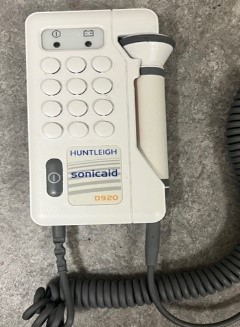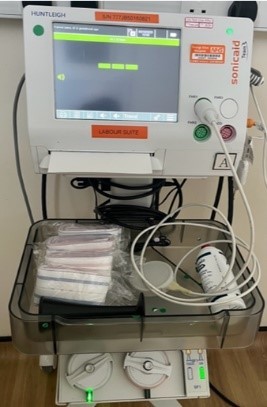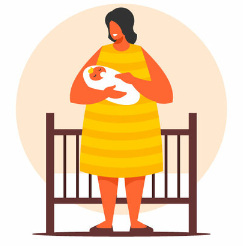What is fetal heart monitoring in labour?
Listening to your baby’s heart rate in labour can 
The benefits of fetal heart monitoring in labour are:
The midwife/doctor may be able to detect that your baby is not coping very well with labour and discuss a plan of care with you if there are any concerns.
The risks of fetal heart monitoring in labour are:
There can be times that it is hard to interpret your baby’s heart rate pattern and it doesn’t always reflect accurately how well the baby is coping. This may lead to extra intervention.
How is the baby’s heart rate monitored?
Your baby’s heartbeat can be monitored in 2 ways:
Intermittent Auscultation: Using a handheld doppler and listening at regular intervals.
Continuous Electronic Fetal Monitoring: Using a CTG (cardiotocograph) machine to monitor the fetal heart rate continuously.
The midwives and doctors will advise you depending on your individual risk factors, which method would be recommended for you in labour.
If you do not have any significant health problems and an uncomplicated pregnancy, then intermittent auscultation would be recommended.
If you have a health problem or a complication in pregnancy that may put you or your baby at increased risk, then continuous electronic fetal monitoring would be recommended.
Choosing to have your baby monitored in labour and how is your choice, we are here to provide you with information and support you.
Intermittent Auscultation
This is performed by using a Pinnard Stethoscope or 
During the second stage of labour the baby’s heart rate is monitored every 5 minutes for 1 minute after a contraction.
Intermittent Auscultation is the only method of monitoring your baby’s heart rate if you choose to have a home birth.
Continuous Electronic Fetal Monitoring
This is performed using a transducer to monitor the
These sensors are linked to a CTG machine which provides a display of the baby’s heart rate and a continuous print out of the pattern.
The midwives and doctors will review the heart rate pattern frequently to assess if the baby is coping well with labour.
Difficulties with fetal heart rate monitoring
Continuous electronic fetal monitoring can restrict your movement during labour. However, we have two machines available that have wireless transducers which are also waterproof. This enables free movement and use of the birth pool if it is safe to do so.
Fetal Scalp Electrode
Sometimes it can be difficult to record the baby’s heart rate using the transducer, this can be due to the baby’s position or when in certain positions during labour. It can also be more common for women with a raised BMI (body mass index). If this happens, your midwife or doctor may suggest attaching a small electrode to the baby’s head during a vaginal examination, this is recommended to be able to hear the baby’s heart rate clearly.
What other options are there?
The kind of monitoring you have while you are in labour is your choice.
If you are reluctant to have any fetal heart rate monitoring, it would be best to discuss this further with your midwife/doctor. You can make an informed decision and a plan can be recorded in your notes to inform everyone who may care for you in labour. Of course, you can change your mind at any time.
Other indications that your baby is coping well in labour:
The baby’s movements. However, it can be difficult to notice movements during contractions.
The colour of the amniotic fluid (your waters) should be clear. If the fluid is green, black or blood stained we would strongly recommend continuous electronic fetal monitoring to closely observe the baby’s heart rate.
Where can I find more information?
If you would like to speak to a midwife about the information in this leaflet, please contact your community midwife.
If you have any concerns with your baby’s movements, please call the 24-hour Maternity triage: 02476 865246
George Eliot Hospital is a smoke free environment. For help and advice to stop smoking you can call the national helpline on 0300 123 1044 or visit https://
Copyright
Images: Pregnant Woman and Mom with her baby are in the Public Domain, CC0
Except where otherwise noted, this item is licensed under the CC BY license (https://
If you are a rights holder and are concerned that you have found material on our patient information resources website, for which you have not given permission, or is not covered by a limitation or exception in national law, please contact us using the Feedback form providing your contact information and full details of the material.